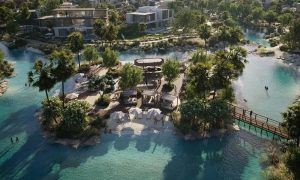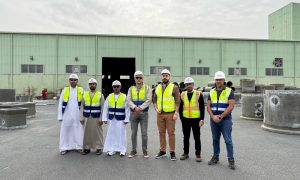Safe and sound
In August this year Shell commended Al Jaber and Partners for their 19 million hour record for zero lost time to accidents on site of the world’s largest GTL facility. Now three months from completion The Big Project finds out how it was achieved. Even before it is due to become fully operational in […]

In August this year Shell commended Al Jaber and Partners for their 19 million hour record for zero lost time to accidents on site of the world’s largest GTL facility. Now three months from completion The Big Project finds out how it was achieved.
Even before it is due to become fully operational in December this year, Al Jaber and Partner’s (AJP) Effluent Treatment Plant (ETP), in Ras Laffan Industrial City,Qatar, is already setting world standards for both size and safety.
By the end of 2011, the plant will be the world’s largest such facility for the recovery, treatment and re-use of industrial process water and is already certified as being one of the safest sites in the region, following the achievement of 19 million hours with zero lost time incidents (LTI); the highest safety record to date for both AJP and project partner Shell.
At the peak of construction, the project involved more than 52,000 workers from over 50 nations. Today, AJP has 1500 men working on a project for one of the most hazardous sectors, with AJP business development manager Eng Ammar Ammar saying the achievement is down to strong communication and clear cut standards.
“The oil and gas industry is ranked in the top three most hazardous work environments in the world and therefore health and safety standards must be adjusted to that fact.
“However AJP comes from a strong health and safety background and therefore we are used to work in such an environment,” Ammar elaborates to add that a “remarkable” number of training initiatives were in place to ensure continuous awareness of the zero LTI goal.
These included a dedicated training coordinator, centralised training centre supported by satellite training sites.
“The impact of the initiative was measured by the total number of hours worked without any accidents, thus Al Jaber completed the construction of the world’s largest ETP with zero LTI in 20 million hours; this was done through meticulous planning and working to set safety standards through an Integrated Management System.
“This was established by cooperating with all parties involved and aligning the safety performance expectations, setting out rules and establishing standards,” Ammar adds.
In addition to the certification awarded by Shell, AJP also holds the ISO 9001, OHSAS 18001 and ISO 14001 certifications in recognition of occupational health and safety standards in addition to environmental and high quality management systems.
Responsible for the full civil and structural work, mechanical steel tank and equipment and piping installation works, AJP’s share of the project is worth QR 735,000,000; it is one of the company’s most significant construction projects to date.
Jointly owned by Qatar Petroleum and Shell, the ETP project is also currently the single largest investment by Shell with a value of between US $18 to $19 billion.
When completed, it should be the world’s largest integrated GTL complex, however such industrial activity requires copious amounts of water. The plant is designed to be fully self-sufficient in its use of water, with capacity to treat 280,000 barrels of water a day – all the water produced as a by-product of the GTL process – making it comparable to a plant for a town of 140,000 people.
After cleaning the industrial water by removing trace metals, hydrocarbons and any particles, most water is used for cooling by evaporation and for steam systems. Some of it will be used for planting bushes, shrubs or trees at the plant.
“When fully operational the amount that Pearl GTL will produce makes it possible to run the plant without drawing on Qatar’s scarce natural fresh water resources or on seawater,” says Rob Overtoom, technology manager on the Pearl GTL project.
The project isn’t just significant for AJP, it is projected to increase Shell’s worldwide production capacity by 8%; a primary contributor to the company’s growth over 2012.
Using resources from the world’s largest single gas field – discovered by Shell in 1971 – the completed facility will process an estimated three billion barrels of oil over its lifetime.
The gas field, known as the North Field in the Arabian Gulf, contains more than 900 trillion cubic feet of gas, equivalent to 150 billion barrels of oil, or over 10% of worldwide gas resources, according to Shell. The plant will manufacture a number of products (See below).
The Effluent Treatment Plant (ETP) project is designed, constructed and commissioned to optimise the management of a water processing system aimed at achieving zero liquid discharge into the natural environment; a standard never before known on such a project.
Thus, the plant is dedicated to the treatment and recycling of industrial effluents that would be produced from this massive industrial complex.
“The complex operational function of the plant required the design development of an integral mass balance, based on several constraints provided in the project brief,” Ammar comments.
According to data, Pearl GTL opens a new global market for Qatari natural gas and allows Qatar to contribute constructively to improve the local environment by supplying a cleaner alternative fuel for transport requirements.
The fuel produced has been tested by Shell in conjunction with Toyota, Volkswagen and DaimlerChrysler to prove it emits fewer emissions than standard diesel. With expertise in all aspects of GTL works, Shell’s middle distillate synthesis (SMDS) technology has been supporting such developments as Malaysia’s Bintulu GTL plant, to increase production. It is the result of three decades of R&D.
Meeting demand
When the project started in 2006 the world was at the height of a construction boom; contrary to some of the benefits that may bring, Ammar say the benefits were short lived with extra pressure on budgets created by the high demand for labour and materials.
“During the period of construction, resources were scarce and once found prices were extremely expensive; one good example would be the prices of steel and oil, which reached $147 per barrel.”
The implementation of procurement strategies such as long term agreements, also helped AJP to garner commitment from its suppliers and striking partnerships with recruiting agents and training schemes to hand pick workers with the necessary skills prior to mobilising in Qatar.
“The same was true for human resources, in such a highly technical project, a high turnover of human resources could lead to a serious delay in the works. We overcame these issues through meticulous planning and innovative procurement strategies,” Ammar explains, adding:
“Every project provides different challenges, however, AJP through its experience has ensured that all necessary procedures of dealing with unknowns are clearly established and provide a flexible approach so that they can be updated and amended to adapt to any occurring situations.”
Other initiatives included the Flawless Start-up initiative (FSI) driven by Shell, of which, Ammar comments: “Systematic approaches were formulated, which were imbedded into the work operations requirements
for the workforce and included the suppliers and subcontractors involved in this project.” He adds that it was an idea developed with the concept “build it right first time” employed from the start.
Established by its Abu Dhabi-based parent company Al Jaber Group, Al Jaber and Partners Qatar has also worked on New Doha International Airport (NDIA) and the community area and design and construction of North Site Utility Tunnels for Qatar Foundation, Education City. Now well established in the country, it has has four asphalt and nine screening and crushing plants in Qatar and has provided labour camp facilities in Ras Laffan, Al Khor Lusail and Messaied for 6,000 labourers in addition to its 1,400 sqm head office in Doha.
The Pearl GTL project is part of a joint venture with OTV and French company Saipem. Upon announcement of the 19 million hours with zero LTI, AJP business development manager Ammar, was quoted as saying: “Safety is part of how we do business. It provides us with a permit to operate. In addition, the project needed to run smoothly, be delivered on time, to budget and to the highest quality standards.
“This is our company’s modus operandi, always aiming for the very best for our clients.”
Adding that AJP is committed to health and safety, Ammar says: “To us it is not about numbers but about surviving lives.
“We look at the bigger picture and we believe that a small incident on a site could cost all the cost cutting one might make by reducing health and safety measures.
Therefore, to us the risk is simply not worth taking especially when we are talking about people lives,” he concludes.
Construction of the plant comprised the following:
• 128,000m³ of earth works
• 76, 000m³ of concrete
• 23 steel tanks erected ranging up to 28, 000m³
• 23 concrete tanks ranging up to 23,000m³
• 323,000 ID of piping
• 4,500 tons of structural steel
• 90 units of tanks & vessels installed up to 30m high
• 9,988 units of instruments
• 1,755,000m of electrical and instrumentation cables
• 65,000m² of mechanical piping painting
• 33,500m² of structure painting
• 16, 000m² insulation.
• Budget:
Al Jaber & Partners’ share of the
works valued at QR 735,000,000 for the full civil and structural work, mechanical steel tank and equipment and piping installation works
• Workers on site: 1,500
The Pear l GTL Complex co mprises three processes :
• a process dedicated to the upgrading of cooling water to process water;
• a process dealing treating suspended oil and wax containing GTL complex effluents
• a process combining and upgrading non oily
and prior de-oiled effluents from the Pearl GTL into various qualities of re-usable process / irrigation water.
• In addition, the whole process is to be fully a ‘Zero Discharge Facility’ – something that has never been achieved for this type of process.




















